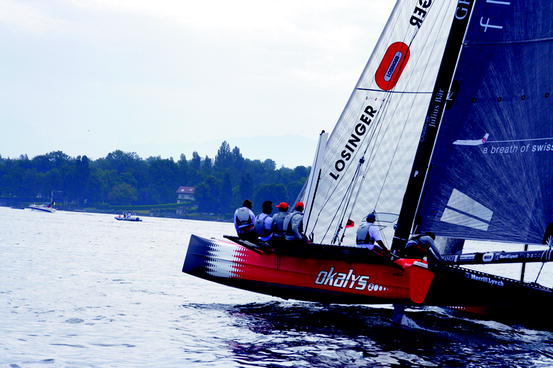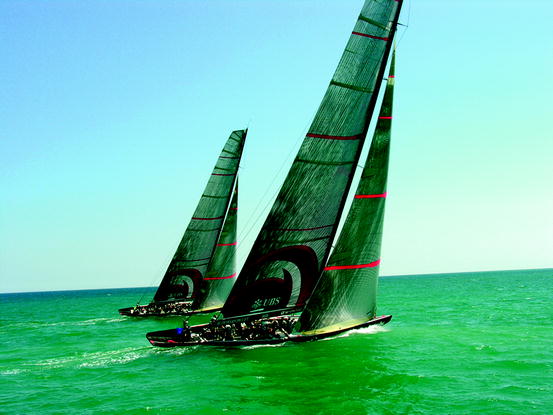Distance (m)
Date
Skipper
Yacht
Duration
Speed
Transatlantic W > E Ambrose Light to Lizard Point
2,880
2009
Pascal Bidegorry
Banque Populaire
3 day 15 h 25 min
32.94 kts
Transatlantic W > E Ambrose Light to Lizard Point (single handed)
2,880
2008
Thomas Coville
Sodebo
5 day 19 h 30 min
20.87 kts
Round-the-World Nonstop Crewed (any type)
21,760
Jan–Mar 2010
Franck Cammas
Groupama 3
48 day 7 h 44 min
18.76 kts
Round-the-World Female Nonstop (single handed)
21,760
Nov 2004–Feb 2005
Dame Ellen MacArthur
B&Q
71 day 14 h 18 min
12.66 kts
In offshore sailing, the 24-h distance record was set in 2009 by Pascal Bidegorry sailing a 131″ trimaran Banque Populaire 5, covering a distance of 908.2 nm corresponding to a speed of 37.84 kts [2].
Dinghy Sailing
Dinghy sailing may be performed on lakes, landlocked areas of water, or close inshore. Dinghies are small boats with one or two sails and a center or dagger board with a rudder. The centerboard or dagger board may be raised or lowered depending on the side-to-side balance of the boat. Boats are typically crewed by one or two people. The positioning of the crew within the boat and the strength and direction of the wind determine the speed and direction of the boat.
The crew may sit leaning over the side of the boat with their feet held in straps. This is termed hiking and allows the crews’ weight to generate righting moments to counteract the heeling forces of the boat. A heeling force is generated by wind across the sails causing the boat to tip away from the direction of the wind [3].
The use of a trapeze allows the crew to hang outside the boat on a harness; thus, their weight can be taken further from the midline of the craft (Fig. 10.1). When using a trapeze, the crew person sits in a harness and is suspended from the mast by halyards.
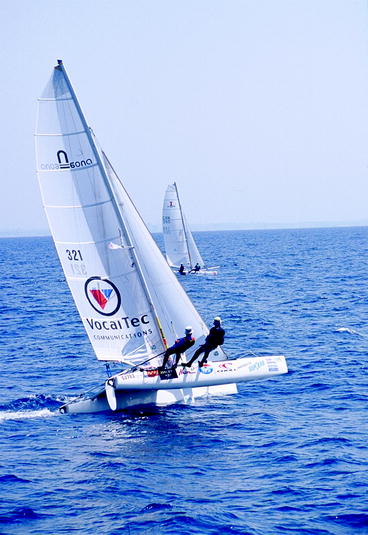

Fig. 10.1
The use of a trapeze to allow crew to position their weight over the side of the catamaran (Photo: Omer Mei-Dan)
The speed of the boat also depends on the design of the hull. Narrow-hulled vessels may be supported by additional hulls or outriggers. Two-hulled craft are called catamarans (Fig. 10.2) and three hulls a trimaran. Advanced hull shapes allow lighter boats to plane and rise out of the water on their own bow wave and skim across the surface. Further advances include the placement of battens in the mainsail and aerodynamic rotating masts.
The traditional Olympic triangle course consists of an equilateral triangle, three equal sides and angles of 60°, and a ratio of windward to reaching legs of 1:1 (Fig. 10.3). From the start, sailors beat or work to windward from the starting line to the top weather or windward mark, with a first reaching leg to the wing mark, also known as the jibe mark; a second reaching leg from the wing mark to the bottom or leeward mark, called a hot dog; a beat to the top mark with a square run back to the bottom mark; another lap; and then a beat to the finish line. The finish line may be at the top mark or may be set beyond the top mark.
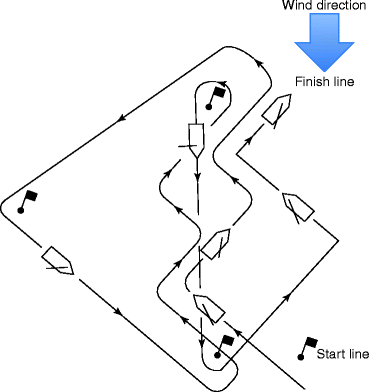

Fig. 10.3
The Olympic sailing course
Yacht Sailing
Yachting tends to be the recreational or competitive sailing of a large vessel specifically designed for this purpose. These are typically specifically built racing monohull or multihull vessels. Yacht races may consist of short races of several hours duration around a specific course up to long-distance round-the-world voyages either nonstop or with multiple stop-off points. Given the cost of these boats, it is not surprising that racing tends to occur at a professional corporate level with full-time crews preparing with extensive training programs.
The oldest of these races may be considered to be the America’s Cup (Fig. 10.4). This competition was established following a challenge to the American yacht racing club in New York in 1851. This trophy has been held by New York Yacht Club until 1983 when they were finally beaten by Australia II from the Perth Yacht Club [4].
The first round-the-world yacht race took place in 1973. Originally sponsored by Whitbread, it is now known as the Volvo Ocean Race and incorporates a distance of 39,000 miles with yachts passing through the most treacherous seas on the planet. There are around five stop-off points at which yachts may be repaired and supplies replenished. This race is undertaken by professional crews and skippers and takes place every 4 years.
The amateur version is called the Clipper Round the World Yacht Race and passes through much smoother waters. Sailors pay the organizers to compete and are formed into crews led by a professional skipper and race identical yachts.
The Vendee Globe single-handed nonstop race was founded by Philippe Jeantot in 1989 and also takes place every 4 years. In this race, sailors compete in monohulls and pass through electronic waypoints according to global positioning systems, starting and finishing in Sables-d’Olonne in France.
Shorter but also challenging races include the Single-Handed Transatlantic Race (STAR) or the Rolex Sydney to Hobart Yacht Race.
Injury Incidence and Mechanisms
The activity characteristics of those sailors competing on dinghies and yachts are similar in some respects however different in others. Both involve physical strength with sudden bouts of anaerobic activity in cramped confined conditions. Both have significant differences related to on-deck activity.
Given the large number of recreational participants in both dinghy sailing and yachting, it is virtually impossible to determine injury rates in this aspect of the sport. Questionnaire surveys may gain some insight but these are subject to recall bias.
Organized regattas, competitions, and races allow a degree of data collection and epidemiological study. The relatively large infrastructure and financial resources of yacht racing have meant that much of the published literature has come from this aspect of the sport. The epidemiological studies of America’s Cup racing have yielded useful information. This event consists of a series of match races of two boats at a time. Each race lasts 2–3 h, and teams may compete in up to 50 races during the event taking place over 22 weeks. The competition is held every 3–4 years [4].
We present the current literature in both dinghy sailing and yachting and discuss the specific injuries involved.
Injuries Characteristics with Dinghy Racing
The literature is limited for injuries related to dinghy sailing and racing. This is undoubtedly related to the considerable numbers of amateur participants. The published literature, principally on national squads and Olympic teams, may therefore have an elite bias with regard to certain patterns of injury. These injuries are likely to occur at a lesser extent in the recreational sailor and are therefore worthy of note to medical personnel providing healthcare for these athletes.
Incidence
In elite Olympic class sailing, the incidence of injury is approximately 0.2 injuries/athlete/year with the lumbar and thoracic spine and knee most commonly injured. Injuries in Paralympic class sailing were found to be at a much higher rate of approximately 100 injuries/1,000 days of sailing in 1999. This is a considerable discrepancy, which was thought to be due to more difficult sailing conditions. The majority of injuries were chronic in nature, predominantly sprains and strains of the upper extremity [5]. This may have been due to the level of disability of the competitors.
Nathanson has reported an online survey of recreationally competitive sailors performed during 2006 looking at the relative frequency, patterns, and mechanisms of sailing-related injuries in dinghies and keelboats [6]. A total of 1,715 injuries were reported from 1,188 respondents. The rates of injury and severe injury were 4.6/1,000 and 0.57/1,000 days of sailing, respectively.
A retrospective review of injuries at the Kiel Regatta from 1984 to 1987 showed that sailing injuries requiring hospital care were three times more common in male competitors and twice as likely from sailing dinghies than keelboats [7]. Another series reporting from a similar event revealed that there was a higher risk of injury for the helmsman than for the fore deckhand but injuries were equally distributed among the sexes [8].
Region
When we compare the anatomical regions where injury was reported, there appears to be a distinction between those injuries reported by elite competitors and recreationally competitive sailors versus beginners.
A review of the 2002 Brazilian Olympic team revealed that the most common painful areas were the lower back (52.9 %) and the knees (25–32 %). In Legg’s series, 57 % of New Zealand Olympic sailors’ injuries were reported in the preceding 3 years, with lower back (45 %), knee (22 %), shoulder (18 %), and arm (15 %) reported [9]. The most common injuries in the Kiel Week regatta were again back (44 %) and knee pain (30 %) [10].
By comparison, when participants of beginner dinghy sailing courses were reviewed, the distribution of injuries was as follows: upper limbs 39.5 %, head 32.4 %, lower extremities 39.5 %, and the neck or the trunk 1.6 % [8]. This distinction may well be due to the reporting of injuries and the exertion involved. Beginner sailors when questioned may well report all minor knocks, scrapes, and aches, whereas experienced sailors may discount these minor injuries and only report only significantly injured areas. Similarly inexperienced sailors may be in the boats sailing but not necessarily applying the same exertion in the process of sailing the boat.
Type
Contusions were the most common injury (55 %), followed by grazes (17 %), cuts or tears (14.3 %), bruises (6.3 %), tender spots or blisters or callus (4.6 %), lacerations (1.7 %), pulled muscles (0.4 %), and fractures (0.4 %) in sailing at the Kiel Regatta [8].
Scholne also reports on the same regatta but a different cohort of patients with a similar pattern of findings. Injuries reported featured as open wounds (31.3 %), hand injuries (31.3 %), head injuries (22.1 %), contusions (19.7 %), and various fractures (15.1 %) [7].
In Nathanson’s survey reporting on 70 severe injuries, 25 % were fractures, and 16 % were torn tendons or cartilage. The most frequent injuries for keelboat sailors were leg contusions (11 %), hand lacerations (8 %), and arm contusions (6 %) showing a predilection for upper limb injuries. Injuries sustained in dinghies were leg contusions (11 %), knee contusions (6 %), and leg lacerations (6 %) [11]. Like all surveys, the accuracy of these findings may be subject to a degree of recall bias, with respondents being more likely to remember severe injuries but forget bruises and contusions.
Causalgia
The causes of injuries can be considered to be either accidental acute trauma or overuse activity. Collision with the boom was the most common accidental injury mechanism (31.1 %), followed by putting the rigging up and down (13 %), capsizing (10.5 %), docking and casting off (9.7 %), the handling of sheets (9.2 %), conditions of the harbor (8.8 %), and slipping while on board (6.8 %). Notably stronger and offshore winds made the sailor more accident prone [8]. Injuries in novice and recreational sailing are predominantly acute in nature with contusions and abrasions typically occurring as a result of collisions with the boom or other equipment during maneuvers. The common mechanisms of injury were trip/fall, being hit by object, and being caught in lines. The common factors contributing to injury are tacking heavy weather and jibing.
By comparison, competitive sailing is a physical sport with large forces suddenly applied to muscle groups in order to make the dinghy go faster.
Actions in sailing are sudden sporadic placing muscles at high risk by performing explosive powerful moves. A lack of warming up, stretching, and cooling down surrounding race also increases risk of injury.
Hiking or sitting over the side of the boat with the feet held beneath foot straps places immense strain on the lower back and the knees [12]. In some classes of sailboats, sailors may spend as much as 94 % of the race in the hiking position [13]. Unaccustomed overarching of the back and weak abdominal muscles will lead to excessive loading of the spine. Inadequate leg strength and poor hiking technique are thought to lead to an imbalance between the medial and lateral quadriceps leading to pain [14]. Inadequate fitness training exacerbates muscular imbalances, changing the forces in opposing muscle groups.
When hiking or using a harness to counterbalance the boat with a trapeze, it may be safest to keep the back straight, depending on the hiking style being performed. Using electromyographic analysis to evaluate static hiking, Hall has suggested that body harnesses include rigid padding, shoulder-through-buttock support, and leg strap supports [15].
Maneuvering around the cramped dinghy (Fig. 10.5) and in particular avoiding the boom can be awkward resulting in rotating, hyperextending, locking, or twisting of joints, leading to meniscal or articular cartilage injury principally of the knee.
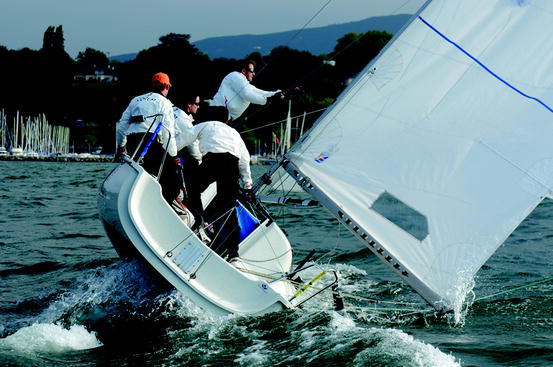

Fig. 10.5
Cramped conditions in dinghy sailing can predispose to injury (David Carlier/www.bivouac44.com)
The handling of the mainsheet against the wind’s resistance to increase the dinghy’s speed may lead to shoulder and arm injuries particularly sudden eccentric loading.
Injury Characteristics of Yachting
Significant injury epidemiological data has come from large-boat yacht racing. These international corporate events often have the medical infrastructure and financial backing, with some teams having overall budgets in excess of £100 m, to permit data collection and observations to be made.
All maneuvers on board are performed manually placing high physical and psychological demands on the 16-person crew. The intensity and demands depend upon the position and role of the athlete, the weather conditions, the race tactics, and the competitiveness of the opposition. The preparation for the events usually occurs over the 4 years on the buildup to the competition. This introduces the aspect of recording injuries sustained during the training phase of preparation as well as during the period of competition itself.
Incidence
Neville et al. have reported on injuries sustained during training for and competition during the 2003 America’s Cup [16]. This prospective study reported an overall incidence of 8.8 incidents/1,000 sailing and training hours. It is interesting to note that there was a higher rate of injury associated with training, 8.6 injuries per 1,000 h of training compared to 2.2 injuries/1,000 h of sailing.
Neville has prospectively studied the injuries sustained by one America’s Cup team during the 2003 competition [16]. The exposure time consisted of 74 weeks of sailing and training, and 220 injuries and 119 illnesses were recorded. This allowed the determination of 5.7 injuries per 1,000 training/sailing hours.
Stay updated, free articles. Join our Telegram channel

Full access? Get Clinical Tree


